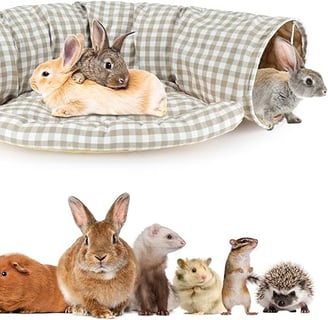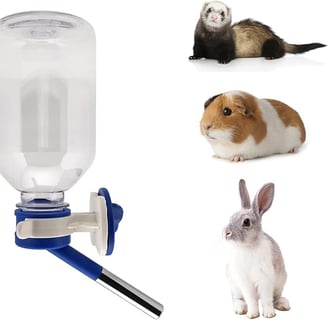Adopting a Rabbit: Essential Tips for Welcoming a Bunny into Your Home
8 min read


Understanding Rabbit Adoption
Adopting a rabbit can be a profound decision for many pet lovers, often driven by a desire to provide a shelter or rescue rabbit with a loving home. This compassion plays a crucial role in why people choose to adopt rabbits, as they seek to help an animal in need rather than purchasing from a pet store or breeder. The act of adopting not only saves a life but also sheds light on the importance of responsible pet ownership in promoting animal welfare.
However, potential rabbit adopters must carefully consider the unique needs of these animals before making a commitment. Unlike traditional pets such as dogs or cats, rabbits have specific dietary and environmental requirements that must be met to ensure their health and happiness. For example, a rabbit's diet should primarily consist of high-quality hay, fresh vegetables, and specialized pellets. Additionally, they require ample space to exercise and explore. Neglecting these factors can lead to serious health issues and behavioral problems, making it essential to prepare adequately for their arrival.
Moreover, adopting a rabbit is a long-term commitment that can last anywhere from 8 to 12 years or more, depending on the breed. Potential adopters must be prepared for the responsibilities that come with rabbit care, including regular veterinary visits, social interaction, and proper living conditions. It is crucial to research and understand the different types of rabbits available for adoption, as they vary significantly in size, temperament, and care requirements. By choosing to adopt from shelters or rescue organizations, individuals can access a variety of breeds while also contributing to the vital mission of reducing the number of homeless animals. In doing so, they not only find a companion but also support a cause that advocates for animal rights and welfare.
Preparing Your Home for a Rabbit
Welcoming a rabbit into your home is an exciting decision, but it also requires careful preparation to ensure a safe and comfortable environment for your new pet. One of the first steps in this process is to designate a living space specifically for your rabbit. This area should be spacious enough for the rabbit to move around freely and have space for activities like hopping, exploring, and playing. A dedicated living space will help the rabbit acclimate to its new home and create a sense of security.
Safety is paramount when preparing your home for a rabbit. You should conduct a thorough survey of your home for potential hazards. Look for items such as electrical cords, small objects that can be ingested, or furniture with sharp edges. Protecting your bunny from these dangers involves rabbit-proofing your home by using wire covers, securing loose cables, and removing any items that could pose a choking hazard. Additionally, it is prudent to consider creating barriers in areas that might be off-limits, allowing your rabbit to explore safely within a defined space.
Choosing the right supplies is another critical aspect of preparing your home for a rabbit. Essential items include bedding, food containers, and a litter box. A comfortable bedding material such as hay or shredded paper should be provided to ensure a cozy and inviting resting area. For the litter box, select one that is easy to clean and appropriately sized for your rabbit. It is also essential to provide a steady supply of high-quality rabbit food and fresh water, which are vital for your pet’s health.
Overall, taking the time to create a safe and welcoming environment will greatly enhance your rabbit's experience as it transitions into your home. Ensuring that the living space is suitable, safe, and equipped with the necessary supplies will help your new furry friend feel right at home. Proper preparation is integral in fostering a happy and healthy relationship with your rabbit.
Essential Supplies for Your New Rabbit
Welcoming a rabbit into your home is an exciting endeavor, and ensuring you have the appropriate supplies is crucial for your new pet's health and happiness. Here is a detailed list of essential items that will help create a nurturing environment for your bunny.
First and foremost, hay is a fundamental staple in a rabbit's diet. It not only aids in digestion but also helps maintain dental health by preventing overgrown teeth. Timothy hay is particularly beneficial, providing the necessary fiber for digestion. It is recommended to supply unlimited hay to your rabbit, as it plays a vital role in their overall well-being.
In addition to hay, high-quality rabbit pellets should be included in their diet, although they should comprise a smaller portion compared to hay. Look for pellets that are specifically formulated for rabbits, as these will contain the essential nutrients your bunny requires. Fresh vegetables can also be incorporated into your rabbit's diet; leafy greens such as kale, romaine, and cilantro are excellent choices. Always introduce new vegetables gradually to avoid digestive issues.
Clean water is another essential supply for rabbits. Providing a water bottle or a bowl ensures your rabbit stays hydrated. Choose a heavy bowl that cannot be easily tipped over, and change the water daily for optimal freshness.
To keep your rabbit entertained and stimulated, it is important to invest in a variety of toys. Chew toys made from natural materials can promote healthy chewing behaviors and help to alleviate boredom. Additionally, grooming tools, such as brushes and nail clippers, are necessary for maintaining your rabbit’s coat and nails, contributing to their overall hygiene.
By gathering and maintaining these essential supplies, you will set the foundation for a happy and healthy life for your new rabbit.
Understanding Rabbit Behavior and Socialization
Rabbits are social creatures known for their unique behaviors and communication styles. Understanding these characteristics is essential for anyone interested in adopting a bunny. Unlike many domestic animals, rabbits communicate mainly through body language and subtle vocalizations. For instance, a relaxed bunny may thump their back legs or perform a joyful hop known as a "binky." Additionally, ear positions can signify various emotions; upright ears indicate curiosity, while flattened ears may indicate fear or aggression. Familiarizing yourself with these signals is crucial in deciphering your rabbit's mood and needs.
Socialization is a vital aspect of rabbit care. These animals thrive in the company of other rabbits and can even form strong bonds with their human caregivers. Spending quality time with your bunny not only fosters trust but also promotes positive behavior and mental stimulation. It is recommended to interact with your rabbit regularly, whether through gentle petting, playtime, or simply being present in the same room. Consistent interaction helps to reassure your bunny and solidifies the bond between you.
When welcoming a rabbit into a household with kids or other pets, gradual introductions are key. Start by allowing your rabbit to get accustomed to their new environment before introducing them to family members. Supervise interactions closely, particularly with other pets, to ensure a harmonious coexistence. It may take time for your bunny to feel comfortable, so be patient and allow them to approach new family members at their own pace. Always encourage gentle interactions and reinforce positive behavior with treats or affectionate gestures. Understanding and catering to your rabbit’s social needs will lead to a fulfilling companionship for both you and your new furry friend.
Health and Veterinary Care for Your Rabbit
Ensuring the health and well-being of your rabbit is crucial for its longevity and quality of life. Regular veterinary care is essential, and pet owners should schedule routine check-ups at least once a year. During these visits, the veterinarian will assess the rabbit’s overall health, check for dental issues, and discuss dietary needs. It is equally important to stay up-to-date with vaccinations; these may include the myxomatosis vaccine and the rabbit hemorrhagic disease (RHD) vaccine, which can protect your pet from serious illnesses.
Spaying or neutering your rabbit not only prevents unwanted litters but also reduces the risk of certain health problems, including uterine cancer in females and aggressive behaviors in males. This surgical procedure can also contribute to better social behavior, making it easier for your rabbit to thrive in a household setting.
Awareness of common health issues faced by rabbits is essential for any pet owner. Some typical problems include dental disease, gastrointestinal stasis, and respiratory infections. It is crucial to recognize signs of illness such as lethargy, loss of appetite, or abnormal droppings, as early detection can significantly impact the effectiveness of treatment. If you notice any unusual behaviors or symptoms, consulting a veterinarian immediately is advised.
Moreover, maintaining a proper diet is key in promoting your rabbit's health. A balanced diet consisting predominantly of hay, along with fresh vegetables and a limited amount of pellets, is essential. Regularly changing water and ensuring a clean living environment also play a critical role in preventing health issues. By prioritizing these aspects of health and veterinary care, you can ensure a happy and healthy life for your furry companion.
Creating a Bond with Your Rabbit
Building a strong relationship with your new rabbit is essential for both their well-being and your enjoyment as a pet owner. A trusting bond can enhance the quality of life for your bunny, making them feel more secure and loved in their new home. The initial approach is vital; let your rabbit explore their surroundings at their own pace without overwhelming them. You can sit quietly nearby, allowing them to come to you when they feel comfortable.
Handling your rabbit requires gentle and calm movements. Hold your bunny securely but not too tightly to avoid causing stress. Support their hindquarters with one hand while placing your other hand around their shoulders. This method of handling allows the rabbit to feel secure and minimizes any anxiety during the process. It is also important to observe their body language; rabbits express emotions through their posture and ears. If your rabbit appears tense or tries to hop away, it is important to respect their space and retry interaction later.
Petting is another avenue through which you can establish trust. Most rabbits enjoy gentle strokes along their back and behind their ears. It is advisable to start slow and observe your rabbit's reaction to your touch. Gradually, as they become accustomed to your presence and handling, you may notice an increase in affection. To enhance your relationship, incorporating playtime is beneficial. Use toys such as tunnel structures, chew toys, or even simple cardboard boxes that allow for exploration and exercise.
Additionally, consider interactive games that stimulate their natural instincts, such as hiding treats within toys or engaging in gentle chasing games. These activities not only foster interaction but also nurture a playful bond between you and your rabbit. Establishing this connection is a rewarding journey, ensuring a fulfilling life together.
Understanding Rabbit Lifespan and Long-Term Commitment
Rabbits have a lifespan that typically ranges from eight to twelve years, with some breeds living even longer. This longevity underscores the critical nature of the commitment involved when adopting a rabbit as a pet. Prospective bunny owners must recognize that welcoming a rabbit into their lives is not just a short-term hobby but a long-term relationship that requires unwavering dedication. The lifespan of a rabbit means that individuals must consider whether their current lifestyle and future plans can accommodate the needs of a pet that may live for a decade or more.
When contemplating adopting a rabbit, it is essential to reflect not only on the joy these animals bring but also on the financial implications of their care. Monthly expenses may include high-quality hay, fresh vegetables, and specialized pellets, while annual costs might encompass veterinary check-ups, vaccinations, and potential emergency medical care. Each of these factors contributes to a comprehensive understanding of the long-term financial commitment necessary for proper rabbit care.
Emotional investment is another vital aspect to consider. Rabbits are social animals that thrive on interaction and companionship. They require time and patience to build trust and develop a strong bond with their owners. Those adopting a rabbit must be certain they can provide the necessary attention, playtime, and social engagement throughout its life. Additionally, environmental factors such as housing and safe play areas must be thoughtfully planned, ensuring that they meet the physical needs of a rabbit while allowing for a stimulating environment.
In summary, adopting a rabbit entails more than simply providing food and shelter. It is an enduring responsibility that requires careful consideration of a variety of factors, including financial, emotional, and environmental commitments. Evaluating these factors will aid in making an informed decision about welcoming a rabbit into one’s home and life.











